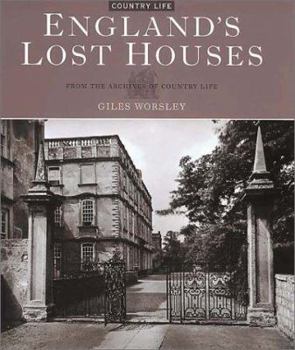England's Lost Houses: From the Archives of Country Life
Select Format
Select Condition 
Book Overview
Of all the photographs in the Country Life archive, none are more poignant than the images of houses that have been lost through demolition or fire. In a great number of cases, the photographs taken... This description may be from another edition of this product.
Format:Hardcover
Language:English
ISBN:1854108204
ISBN13:9781854108203
Release Date:April 2002
Publisher:Aurum Press
Length:192 Pages
Weight:4.70 lbs.
Dimensions:0.9" x 10.1" x 12.3"
Customer Reviews
1 rating
A superb memento to lost beauty - and ugliness...
Published by Thriftbooks.com User , 21 years ago
In `Brideshead Revisited` Charles Ryder worries about the triumph of `Hooper`, the epitome of all that's mediocre and commonplace, over history, tradition and style. His thoughts are visualised to perfection in a deeply depressing photograph in this book, showing a brand-new street of featureless, drab modern 'cottages' perched literally on the doorstep of dilapidated Beaupre Hall, that is about to be torn down altogether. If you have any feeling at all for English country house traditions and architecture, this book will make your heart ache for all the beauty that was burnt, mutilated, abandoned and left to decay, or, most often and worst of all, deliberately demolished - at a staggering rate of one house a week during parts of the fifties. (Some offering fierce resistance though, like the domed core of magnificent Nuthall Temple, that defied all attempts at demolition and was left to itself for decades, until finally a big load of dynamite blew it away so that the M1 motorway could run its course; Nuthall's foundations remain buried underneath it). Well, as you can see it would be very easy to write a soppy, sentimental book about the subject - but fortunately Giles Worsley sticks to an eminently sober, scholarly (but lively!) approach. He notes that we lament the loss of 1 in 6 country houses during the 20th century, but that we might rather wonder at the fact that in a century of such huge political, economical and social changes, 5 in 6 survived! Also, he stresses that the downsizing of huge piles into something more convenient or fashionable is not a 20th century invention, but is of all ages. And who could blame the latter-day nobleman for not wanting to maintain a draughty, 150-bedroom Victorian colossus? (the Duchess of Westminster apparently once said that she thought of Eaton Hall as a town rather than a house - and a stay in the immense, British-designed Lalgarh Palace (now hotel) in Bikaner, India, has certainly taught me that Victorian buildings of that size are hardly fit for human occupation!). In fact, the 20th century is exceptional only because it was the first century to produce legislation AGAINST such activities. And finally, not all that was lost was of great historical or architectural importance - much of it was in fact second-rate, plain or downright ugly.Country Life liberally documented the good, the bad and the ugly (at times snubbing the ugly with elegant irony, some amusing examples of which are cited; at other times providing invaluable visual documentation to inspire later reconstructions), and the breathtaking photographs in this book seem to offer a fairly representative cross-section of all that was destroyed or downsized. The quality of the (black and white) pictures is exquisite. They show a wealth of architectural and interior detail, but many of them are also highly atmospheric, mysterious and haunting. The accompanying text is concise, instructive and always interesting (though inevitably a somewhat depr





